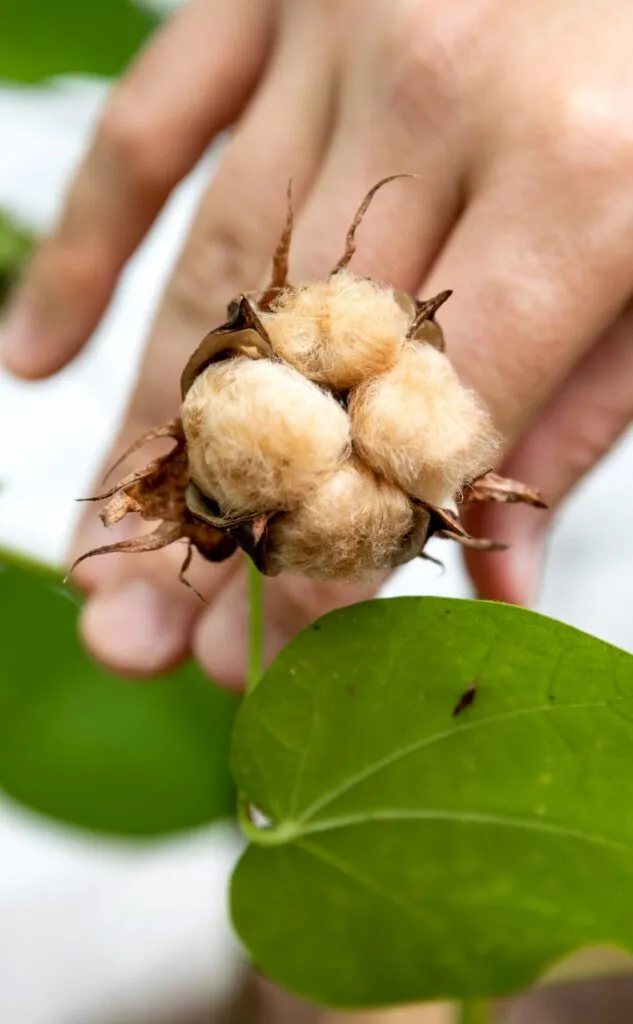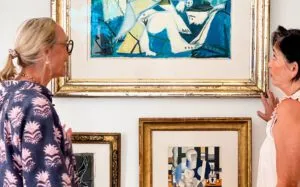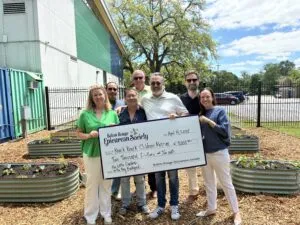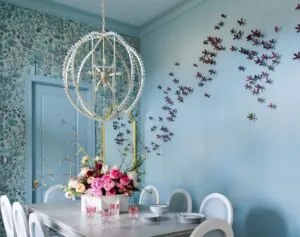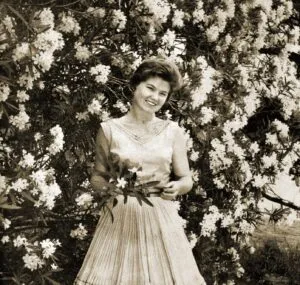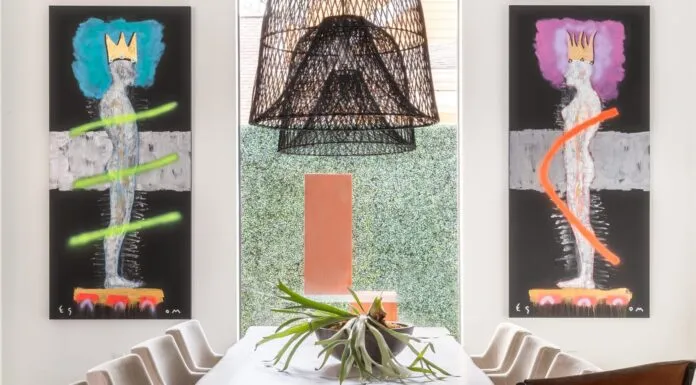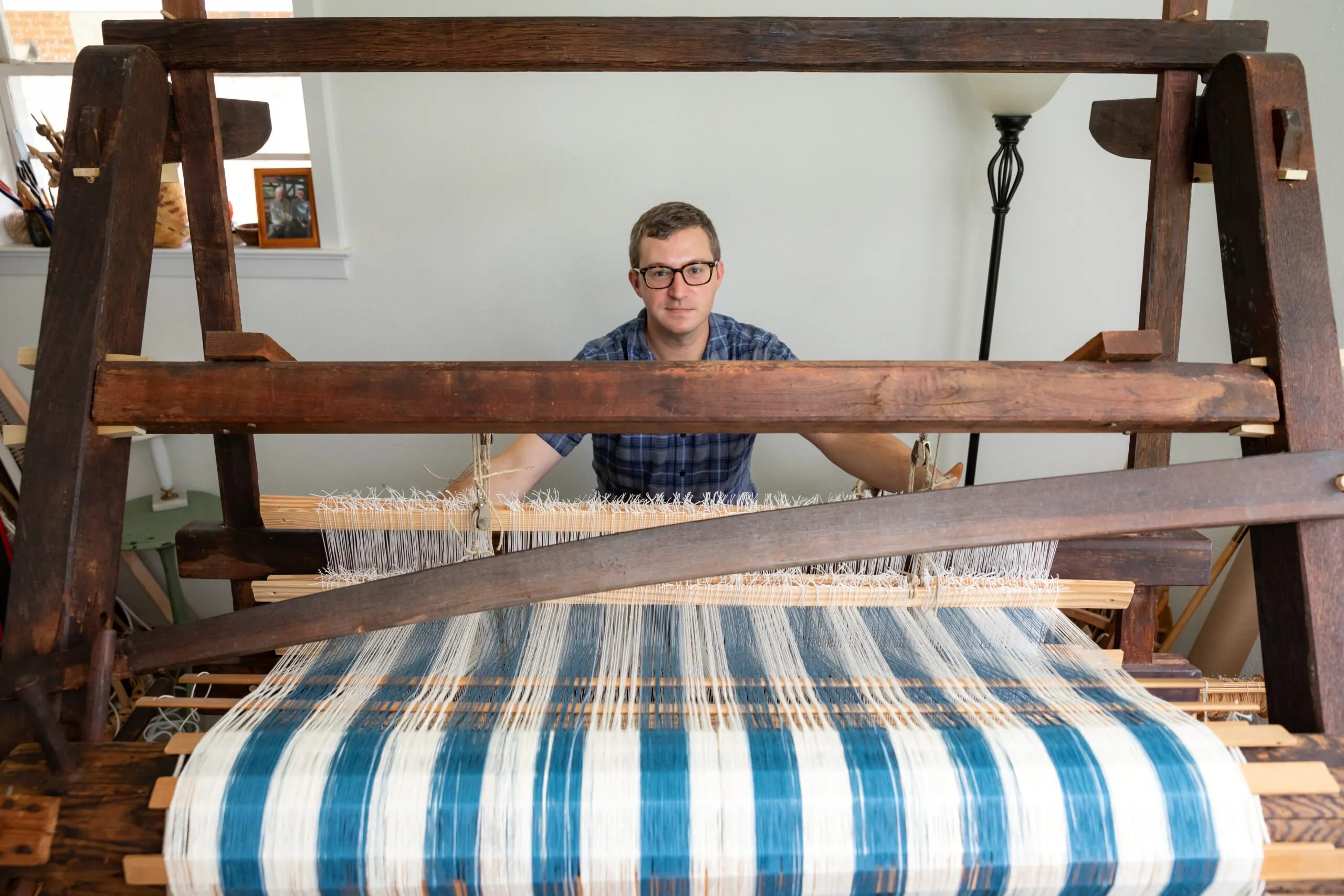
Through spinning and weaving, Austin Clark keeps near-mythical Acadian textiles alive
Stepping out into the glare of another rude summer swelter, Austin Clark is about to show off something that is illegal to grow residentially in most southern states.
Along the west side of his Mid City home stands a row of greenish-brown bushes. Waist high.
“See, the flowers open like this,” he says, lifting one of the bursts of silky white petals. “They aren’t long-lived; they blush and fall right off.”
Next come the bulbs, he says, of which he already has a few showing up further down the row. And then the cotton.
Unlike Mississippi, Arkansas or Tennessee, Louisiana has legalized the growth of ornamental cotton that can be used for homemade textiles and clothing. And cotton is a self-pollinating crop, so it isn’t that tricky to keep alive, though boll weevils remain a threat.
Clark has a future set of napkins on his brain—and on his loom, which takes up the vast majority of what otherwise might be a guest bedroom.
“I’m so excited to finally get to grow my own cotton this year,” says the expert spinner and weaver, who three years ago left Atlanta for south Louisiana with his husband, Shannon Gallier. “This way we start from the very beginning, which feels right. OK there, it’s too hot, let’s go inside.”
Clark has a small electric gin about the size of a toaster, and he scrapes and cards the lint himself before placing the cotton yarn on the loom. A repetitive clatter sounds out rhythmically as his hands and legs move with the machine. As the threads blend into fabric, it’s a workout, and though Clark’s mind can wander while weaving, he remains methodical and disciplined for hours on end. “There’s a lot of muscle memory that happens,” he says.
A Florida native and Mercer University grad who first learned spinning with the Peachtree Handspinners Guild in Atlanta, his pressing projects are a slate of reproductions, rich brown and tan textiles inspired by traditional Acadian blankets and towels.
Since arriving in Baton Rouge and seeking out the details of these nearly endangered methods, Clark has been both a quick study and stalwart ambassador for classic Acadian weaving.
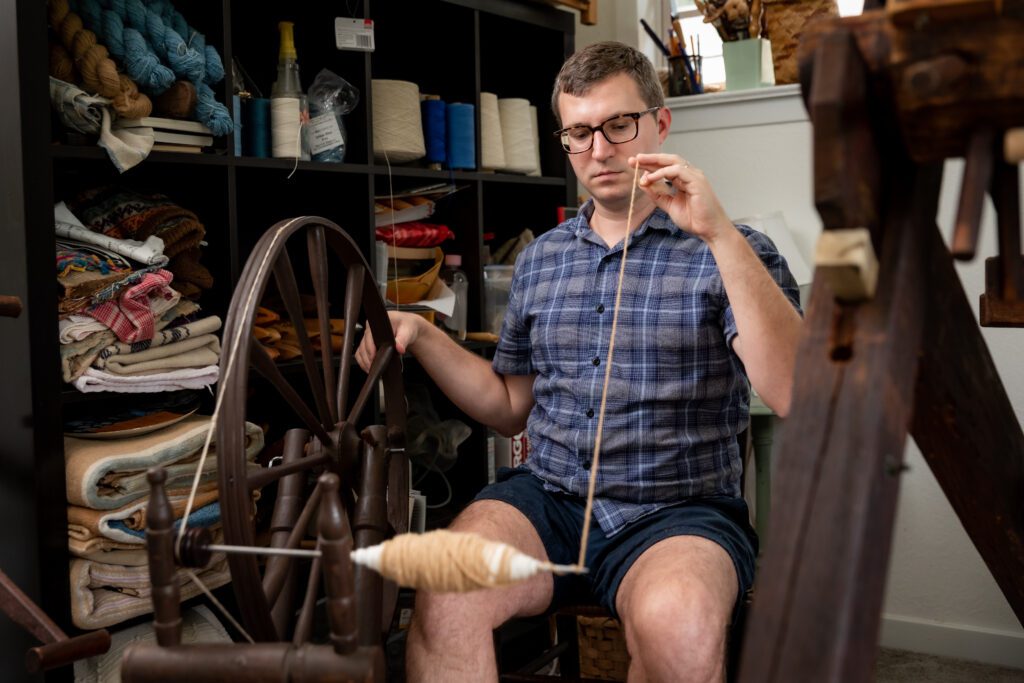
“It’s a respect thing,” Clark says. “I feel like it’s not fully mine to do with whatever I’d like. It’s more about preserving things I’ve documented and remaking them. The preservation is actually the fun part.”
More than 250 years ago, the Acadian techniques for textiles were born of necessity and survival rather than creative choice. Leaving Nova Scotia, the settlers swapped sheep for cotton, with white cotton an exportable cash crop and the native brown cotton cultivated and kept for personal use.
Clark still chooses to use coton jaune, literally “yellow cotton,” though it has a brown appearance akin to the desert Southwest or a chicory coffee with a healthy pour of cream.
“It’s not a complicated weaving process with a two-harness loom, but it’s unique, and that’s the Acadian way—making the best of what you had,” says Elaine Bourque, the longtime standard bearer for Acadian weaving in the Lafayette area, now in her 80s. “They were refugees.
They were used to making do.”
Bourque learned French in the 1960s as a school secretary calling the Cajun-French grandparents of the students when they needed to be picked up early because of illness or bad behavior. She’s woven blankets, placemats and throws for decades now, and she studied and did the festival and state-sponsored workshop circuit with acclaimed weaver Gladys Clark—no relation to Austin—whom she met at Festivals Acadiens et Créoles.
The Acadian way doesn’t allow for intricate pattern work. Minimalism and tasteful indigo dying are the hallmarks of these classic pieces that took Gladys and Elaine to the White House in the 1990s. They met Hillary Clinton. They’ve traveled the country.
“It’s an old method,” Clark says. “But the way the Cajuns hold onto their culture, it’s timeless, too.”
Bourque only agreed to teach Clark because she saw in him someone dedicated to the craft who understands the Cajun tradition and the importance of teaching it. In other words, the perfect apprentice. They participated in a joint gallery exhibit at the Hilliard Art Museum in Lafayette last year.
“I’m getting up there, my time is coming,” Bourque says. “But Austin can do anything, he’s brilliant, and he can pass it on to a new generation who can weave these blankets just like my ancestors did.”
Clark loves reproducing vintage pieces Bourque finds on her hunts because in a world dominated by fast fashion and disposable objects, Acadian weaving puts work and manufacturing back on a human scale.
“I don’t slow down very well,” Clark admits, pouring out water from a tall pitcher while seated at his rustic dining table, a painting of his dachshund looking like a regal Victorian general looking down on him. “I don’t sit still well. With technology we have so much at our fingertips, and I’m just fascinated by the question: What output can one person create?”
Clark sells textiles online at theacadianweaver.com, but his day job is a different creative discipline. Both he and his husband are music directors for well-known regional churches: Gallier at St. James Episcopal in downtown Baton Rouge and Clark at Grace Episcopal in St. Francisville, where he plays organ and directs the choir. Like with weaving, Clark’s musical service to the church is steeped in both tradition and technical craft, and a reverence for safety and comfort.
“My role in liturgy is building an atmosphere for people to have their own personal experience, and that’s not unlike weaving these historical pieces. For others, these blankets can evoke a different meaning or connection. There’s history to Episcopalian liturgy, but it’s progressive, too. It’s nice being a part of the show.”
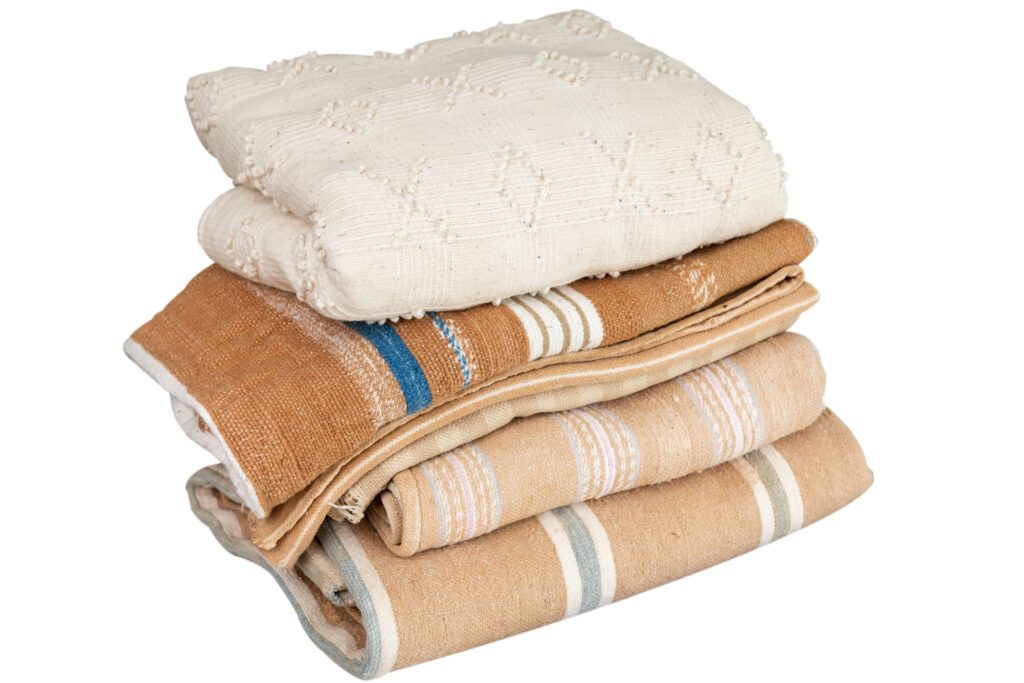
With Bourque as the veteran who has lived in Acadiana her whole life and Clark the younger, talented outsider who immediately appreciated these textiles, local cotton farmer Caleb Fruge says the two weavers make a perfect pair. In fact, it was Clark’s passion for cotton that motivated Fruge to grow it.
“Austin has a real commitment to tradition, and he’s careful,” Fruge says. “This is a lost art. As a Cajun myself, I know it’s important that these skills do not die out.”
On a recent Friday afternoon, Bourque hosted Clark to talk about their collaborative book project. She made lunch. He brought dessert. And they drained two pots of coffee brainstorming. Bourque has been interviewing owners of heirloom Acadian blankets for a decade and documenting her finds from across the region with photos and notes. She’s interested in the women behind the blankets, tireless Acadians who spent all day in the fields, raised a lot of children and made blankets for each.
Clark is working on describing the technical steps of the weaving process as instruction and inspiration for future weavers.
“As far as I know, Elaine and I are the only two people still doing this,” Clark says. “It’s an honor, but there’s almost pressure to do it. This is important to carry on. I have no Cajun blood, but I feel incredibly connected to these people.”
Clark is a guest teacher at Marshfield School of Weaving in Vermont a couple times each year, so thanks to his dedication, Acadian weaving methods are making inroads in the Northeast. Bourque calls him an artist of precision and persistence. He is nothing if not passionate about adopting this Cajun legacy and doing all he can to help it reach further into the culture and the future, be that with his classes, with his blanket reproductions, or with the upcoming book that Bourque promises will be a valuable read and a sight to see.
“I make physical objects, but it’s not really about that, ultimately,” Clark says. “It’s about the story. These are incredible stories of an incredible people, and yet we often need to hold onto something in order to tell that story. So that’s what I do.”




